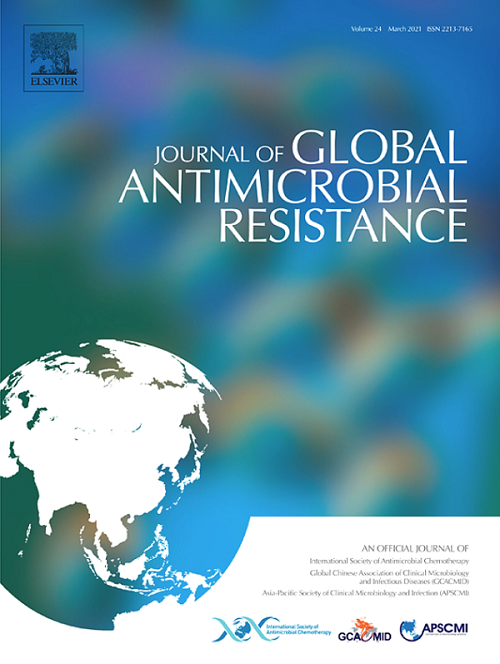非洲环境下粘菌素耐药性的环境调解。系统的范围审查。
IF 3.7
3区 医学
Q2 INFECTIOUS DISEASES
引用次数: 0
摘要
革兰氏阴性菌抗微生物药物耐药性(AMR)的流行是一个主要的全球卫生问题。对粘菌素等最后手段的抗生素的耐药性尤其令人担忧。本研究回顾了环境因素如何在非洲环境下促成粘菌素耐药性,在非洲正在出现关于粘菌素耐药革兰氏阴性菌的报告。方法:使用多个数据库进行系统评价,以确定非洲环境介导粘菌素耐药性的文章。搜索词包括“环境”、“粘菌素”、“移动粘菌素抗性基因”以及相关关键词。本文收录了2015-2021年聚焦非洲的文章。提取有关国家、检测到的基因、使用的方法和细菌种类的数据。结果:847篇文献中,26篇纳入终评。研究主要来自突尼斯、阿尔及利亚、南非、埃及、尼日利亚和刚果。mcr-1基因是检测到的最常见的遗传变异。大肠杆菌是传播mcr基因的优势菌。在人类、动物和环境样本(包括粪便、土壤、水体和野生动物)中发现了耐粘菌素基因。结论:本综述证实了质粒介导的粘菌素耐药基因在非洲的人类、动物和环境中迅速传播。抗性基因在这些储存库之间的移动令人担忧。有必要对粘菌素耐药性机制进行更多研究,并实施全大陆范围的抗生素管理规划,以应对非洲这一新出现的威胁。本文章由计算机程序翻译,如有差异,请以英文原文为准。
Environmental mediation of colistin resistance in the African context. A systematic scoping review
Objectives
The prevalence of antimicrobial resistance (AMR) among Gram-negative bacteria is a major global health concern. Resistance to last-resort antibiotics like colistin is particularly alarming. This study reviews how environmental factors have contributed to colistin resistance in the African context, where reports of colistin-resistant Gram-negative organisms are emerging.
Methods
A systematic review was conducted using multiple databases to identify articles on environmental mediation of colistin resistance in Africa. Search terms included “environment,” “colistin,” “mobile colistin resistance gene,” and related keywords. Articles from 2015 to 2021 focusing on Africa were included. Data on country, genes detected, methods used, and bacterial species were extracted.
Results
Out of 847 articles identified, 26 were included in the final review. Studies were predominantly from Tunisia, Algeria, South Africa, Egypt, Nigeria, and Congo. The mobile colistin resistance (mcr-1) gene was the most common genetic variant detected. Escherichia coli (E. coli) was the predominant organism spreading mcr genes. Colistin-resistant genes were found in humans, animals, and environmental samples including manure, soil, water bodies, and wildlife.
Conclusions
This review confirms the rapid spread of plasmid-mediated colistin-resistant genes in humans, animals, and the environment across Africa. The movement of resistant genes between these reservoirs is alarming. There is a need for more research into colistin resistance mechanisms and implementation of continent-wide antibiotic stewardship programs to address this emerging threat in Africa. © 2024 The Author(s). Published by Elsevier Ltd on behalf of International Society for Antimicrobial Chemotherapy.
求助全文
通过发布文献求助,成功后即可免费获取论文全文。
去求助
来源期刊

Journal of global antimicrobial resistance
INFECTIOUS DISEASES-PHARMACOLOGY & PHARMACY
CiteScore
8.70
自引率
2.20%
发文量
285
审稿时长
34 weeks
期刊介绍:
The Journal of Global Antimicrobial Resistance (JGAR) is a quarterly online journal run by an international Editorial Board that focuses on the global spread of antibiotic-resistant microbes.
JGAR is a dedicated journal for all professionals working in research, health care, the environment and animal infection control, aiming to track the resistance threat worldwide and provides a single voice devoted to antimicrobial resistance (AMR).
Featuring peer-reviewed and up to date research articles, reviews, short notes and hot topics JGAR covers the key topics related to antibacterial, antiviral, antifungal and antiparasitic resistance.
 求助内容:
求助内容: 应助结果提醒方式:
应助结果提醒方式:


